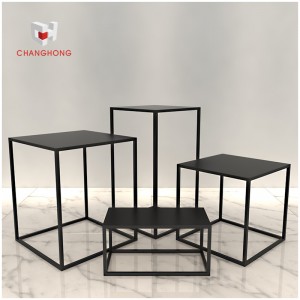ნოე . 26, 2024 14:06 Back to list
Furniture Solutions for Retail Spaces That Enhance Shopping Experiences
The Essential Guide to Retail Store Furniture Creating the Perfect Shopping Environment
In today’s competitive retail landscape, the importance of creating a welcoming and functional shopping environment cannot be overstated. One of the most crucial elements in achieving this goal is the choice of furniture within the store. The right retail store furniture not only enhances the aesthetic appeal of the space but also plays a significant role in influencing customer behavior and enhancing their overall shopping experience.
Understanding the Role of Retail Store Furniture
Retail store furniture serves multiple purposes. Firstly, it establishes the brand identity of the store. Whether you are operating a high-end fashion boutique, a cozy bookstore, or a trendy home décor shop, the furniture you choose should reflect your brand’s ethos and target demographic. For instance, sleek, modern furniture with minimalist designs might be suitable for a contemporary clothing store, while rustic wooden fixtures might be more appropriate for an artisanal craft shop.
Secondly, retail furniture greatly impacts the functionality of the shop. It determines the flow of customer movement and can either enhance or hinder the shopping experience. Cleverly designed furniture can guide customers through different sections of the store, encouraging them to explore and discover additional products. Factors such as layout, arrangement, and accessibility must be considered to create an efficient and inviting space.
Key Types of Retail Store Furniture
1. Display Fixtures These are essential for showcasing products in the most attractive manner. Options include shelves, display cases, mannequins, and racks. Each piece should be strategically placed to highlight promotions and new arrivals while maintaining product visibility.
2. Checkout Counters The checkout area is the final touchpoint for customers before they complete their purchase. A well-designed checkout counter should be functional, allowing for smooth transactions, while also providing an opportunity to display impulse buy items that can increase sales.
3. Seating Areas Creating comfortable seating areas can significantly enhance the shopping experience, especially in stores where customers may spend more time, like clothing shops or bookstores. Providing seating encourages customers to linger and enjoy their shopping experience instead of rushing through it.
4. Fitting Rooms For clothing retailers, fitting rooms are vital. The right furniture in fitting rooms should include mirrors, benches, and hooks. This setup not only facilitates the trial process but also allows customers to feel more comfortable and relaxed.
retail store furniture

5. Signage and Branding Effective signage is crucial for guiding customers through the store and highlighting promotions. Custom furniture pieces can also be used for branding purposes, such as uniquely designed shelves that display the store’s logo or colors.
Choosing the Right Furniture
When selecting furniture for a retail store, it is essential to consider several factors
1. Target Market Understand your customers’ preferences. For example, a furniture store targeting young professionals might opt for sleek, modern designs, while a children’s clothing store may choose bright colors and playful shapes.
2. Space Utilization Evaluate the size and layout of your store. Furniture should enhance space, not overcrowd it. Utilize multi-functional pieces to maximize efficiency without sacrificing style.
3. Quality and Durability Invest in furniture that can withstand the daily wear and tear of a retail environment. High-quality furniture not only looks better but can also save money in the long run by reducing the need for replacements.
4. Budget While it can be tempting to invest heavily in high-end furniture, it is crucial to set a budget that considers both aesthetics and functionality. Look for options that balance style and cost-effectiveness.
Conclusion
In conclusion, retail store furniture plays a vital role in shaping the shopping environment. It influences customer behavior, reflects brand identity, and enhances overall functionality. By carefully selecting the right types of furniture and considering the specific needs of your business, you can create an inviting and effective retail space that attracts and retains customers. Remember, the shopping experience is not just about the products but also about the environment in which they are presented. Investing in quality retail furniture is, therefore, an investment in your business’s success.
-
The Impact of Display Racks on Promoting Sustainable Product Consumption
NewsMay.14,2025
-
The Display Table Is A Catalyst For Sustainable Consumer Engagement
NewsMay.14,2025
-
Sustainable Modern Retail Store Fixtures
NewsMay.14,2025
-
Store Design Innovations for Enhanced Customer Experience and Sales
NewsMay.14,2025
-
How Shoe Shop Displays Influence Sustainable Footwear Choices
NewsMay.14,2025
-
How Display Counter Aids in Efficient Resource Management in Communities
NewsMay.14,2025


















































































































